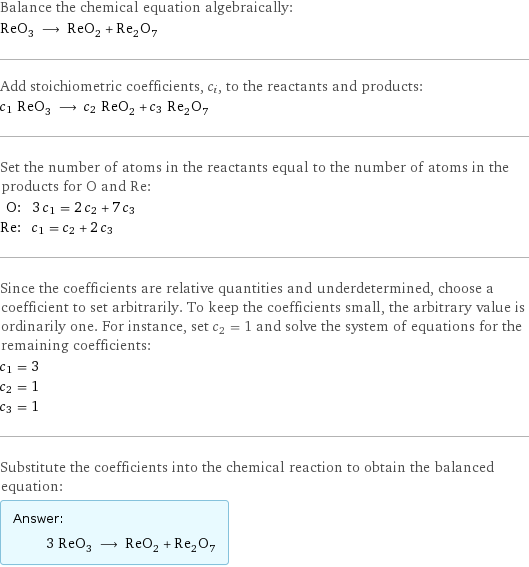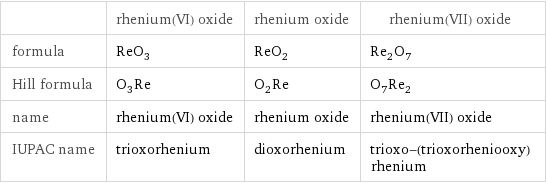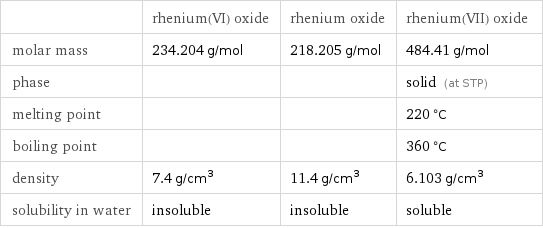Input interpretation

ReO_3 rhenium(VI) oxide ⟶ ReO_2 rhenium oxide + Re_2O_7 rhenium(VII) oxide
Balanced equation

Balance the chemical equation algebraically: ReO_3 ⟶ ReO_2 + Re_2O_7 Add stoichiometric coefficients, c_i, to the reactants and products: c_1 ReO_3 ⟶ c_2 ReO_2 + c_3 Re_2O_7 Set the number of atoms in the reactants equal to the number of atoms in the products for O and Re: O: | 3 c_1 = 2 c_2 + 7 c_3 Re: | c_1 = c_2 + 2 c_3 Since the coefficients are relative quantities and underdetermined, choose a coefficient to set arbitrarily. To keep the coefficients small, the arbitrary value is ordinarily one. For instance, set c_2 = 1 and solve the system of equations for the remaining coefficients: c_1 = 3 c_2 = 1 c_3 = 1 Substitute the coefficients into the chemical reaction to obtain the balanced equation: Answer: | | 3 ReO_3 ⟶ ReO_2 + Re_2O_7
Structures

⟶ +
Names

rhenium(VI) oxide ⟶ rhenium oxide + rhenium(VII) oxide
Equilibrium constant
![Construct the equilibrium constant, K, expression for: ReO_3 ⟶ ReO_2 + Re_2O_7 Plan: • Balance the chemical equation. • Determine the stoichiometric numbers. • Assemble the activity expression for each chemical species. • Use the activity expressions to build the equilibrium constant expression. Write the balanced chemical equation: 3 ReO_3 ⟶ ReO_2 + Re_2O_7 Assign stoichiometric numbers, ν_i, using the stoichiometric coefficients, c_i, from the balanced chemical equation in the following manner: ν_i = -c_i for reactants and ν_i = c_i for products: chemical species | c_i | ν_i ReO_3 | 3 | -3 ReO_2 | 1 | 1 Re_2O_7 | 1 | 1 Assemble the activity expressions accounting for the state of matter and ν_i: chemical species | c_i | ν_i | activity expression ReO_3 | 3 | -3 | ([ReO3])^(-3) ReO_2 | 1 | 1 | [ReO2] Re_2O_7 | 1 | 1 | [Re2O7] The equilibrium constant symbol in the concentration basis is: K_c Mulitply the activity expressions to arrive at the K_c expression: Answer: | | K_c = ([ReO3])^(-3) [ReO2] [Re2O7] = ([ReO2] [Re2O7])/([ReO3])^3](../image_source/bd02ddf2f76b745e2a95f712b0535d7f.png)
Construct the equilibrium constant, K, expression for: ReO_3 ⟶ ReO_2 + Re_2O_7 Plan: • Balance the chemical equation. • Determine the stoichiometric numbers. • Assemble the activity expression for each chemical species. • Use the activity expressions to build the equilibrium constant expression. Write the balanced chemical equation: 3 ReO_3 ⟶ ReO_2 + Re_2O_7 Assign stoichiometric numbers, ν_i, using the stoichiometric coefficients, c_i, from the balanced chemical equation in the following manner: ν_i = -c_i for reactants and ν_i = c_i for products: chemical species | c_i | ν_i ReO_3 | 3 | -3 ReO_2 | 1 | 1 Re_2O_7 | 1 | 1 Assemble the activity expressions accounting for the state of matter and ν_i: chemical species | c_i | ν_i | activity expression ReO_3 | 3 | -3 | ([ReO3])^(-3) ReO_2 | 1 | 1 | [ReO2] Re_2O_7 | 1 | 1 | [Re2O7] The equilibrium constant symbol in the concentration basis is: K_c Mulitply the activity expressions to arrive at the K_c expression: Answer: | | K_c = ([ReO3])^(-3) [ReO2] [Re2O7] = ([ReO2] [Re2O7])/([ReO3])^3
Rate of reaction
![Construct the rate of reaction expression for: ReO_3 ⟶ ReO_2 + Re_2O_7 Plan: • Balance the chemical equation. • Determine the stoichiometric numbers. • Assemble the rate term for each chemical species. • Write the rate of reaction expression. Write the balanced chemical equation: 3 ReO_3 ⟶ ReO_2 + Re_2O_7 Assign stoichiometric numbers, ν_i, using the stoichiometric coefficients, c_i, from the balanced chemical equation in the following manner: ν_i = -c_i for reactants and ν_i = c_i for products: chemical species | c_i | ν_i ReO_3 | 3 | -3 ReO_2 | 1 | 1 Re_2O_7 | 1 | 1 The rate term for each chemical species, B_i, is 1/ν_i(Δ[B_i])/(Δt) where [B_i] is the amount concentration and t is time: chemical species | c_i | ν_i | rate term ReO_3 | 3 | -3 | -1/3 (Δ[ReO3])/(Δt) ReO_2 | 1 | 1 | (Δ[ReO2])/(Δt) Re_2O_7 | 1 | 1 | (Δ[Re2O7])/(Δt) (for infinitesimal rate of change, replace Δ with d) Set the rate terms equal to each other to arrive at the rate expression: Answer: | | rate = -1/3 (Δ[ReO3])/(Δt) = (Δ[ReO2])/(Δt) = (Δ[Re2O7])/(Δt) (assuming constant volume and no accumulation of intermediates or side products)](../image_source/f8327493a4c77ec6bc2a0d1200f84eb8.png)
Construct the rate of reaction expression for: ReO_3 ⟶ ReO_2 + Re_2O_7 Plan: • Balance the chemical equation. • Determine the stoichiometric numbers. • Assemble the rate term for each chemical species. • Write the rate of reaction expression. Write the balanced chemical equation: 3 ReO_3 ⟶ ReO_2 + Re_2O_7 Assign stoichiometric numbers, ν_i, using the stoichiometric coefficients, c_i, from the balanced chemical equation in the following manner: ν_i = -c_i for reactants and ν_i = c_i for products: chemical species | c_i | ν_i ReO_3 | 3 | -3 ReO_2 | 1 | 1 Re_2O_7 | 1 | 1 The rate term for each chemical species, B_i, is 1/ν_i(Δ[B_i])/(Δt) where [B_i] is the amount concentration and t is time: chemical species | c_i | ν_i | rate term ReO_3 | 3 | -3 | -1/3 (Δ[ReO3])/(Δt) ReO_2 | 1 | 1 | (Δ[ReO2])/(Δt) Re_2O_7 | 1 | 1 | (Δ[Re2O7])/(Δt) (for infinitesimal rate of change, replace Δ with d) Set the rate terms equal to each other to arrive at the rate expression: Answer: | | rate = -1/3 (Δ[ReO3])/(Δt) = (Δ[ReO2])/(Δt) = (Δ[Re2O7])/(Δt) (assuming constant volume and no accumulation of intermediates or side products)
Chemical names and formulas

| rhenium(VI) oxide | rhenium oxide | rhenium(VII) oxide formula | ReO_3 | ReO_2 | Re_2O_7 Hill formula | O_3Re | O_2Re | O_7Re_2 name | rhenium(VI) oxide | rhenium oxide | rhenium(VII) oxide IUPAC name | trioxorhenium | dioxorhenium | trioxo-(trioxorheniooxy)rhenium
Substance properties

| rhenium(VI) oxide | rhenium oxide | rhenium(VII) oxide molar mass | 234.204 g/mol | 218.205 g/mol | 484.41 g/mol phase | | | solid (at STP) melting point | | | 220 °C boiling point | | | 360 °C density | 7.4 g/cm^3 | 11.4 g/cm^3 | 6.103 g/cm^3 solubility in water | insoluble | insoluble | soluble
Units
